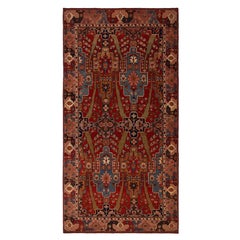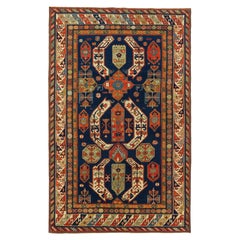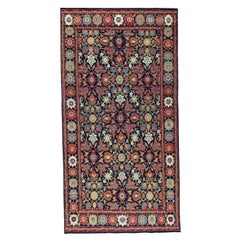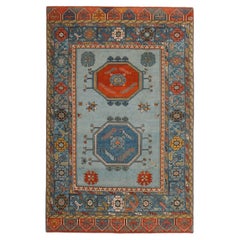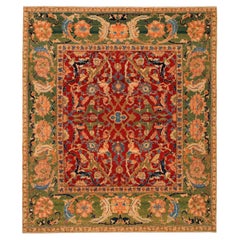ARARAT RUGS
to
6
504
215
199
82
76
57
21
18
5
2
1
1
295
Ararat Rugs the Alaeddin Mosque Flowers and Stars Lattice Carpet, Natural Dyed
By Ararat Rugs
Located in Tokyo, JP
The source of the carpet comes from the book Orient Stars Collection, Anatolian Tribal Rugs 1050-1750, Michael Franses, Hali Publications Ltd, 2021 fig.23. This 13th-century carpet is from probably the Konya region, central Anatolia, circa 1200-1300 (C 1290-1420). It is exhibited at the Museum of Turkish and Islamic Arts...
Category
21st Century and Contemporary Turkish Revival Turkish Rugs
Materials
Wool, Natural Fiber, Organic Material
Ararat Rugs the Barbieri Tree Design Carpet, Persian Revival Rug, Natural Dyed
By Ararat Rugs
Located in Tokyo, JP
The source of carpet comes from the book Orient Star – A Carpet Collection, E. Heinrich Kirchheim, Hali Publications Ltd, 1993 nr.64 and Islamic Carpets, Joseph V. McMullan, Near Eas...
Category
21st Century and Contemporary Turkish Revival Persian Rugs
Materials
Wool, Natural Fiber, Organic Material
Ararat Rugs Lenkoran Rug Caucasian Revival 19 Century Carpet, Kazak Natural Dyed
By Ararat Rugs
Located in Tokyo, JP
The rug source comes from the book Tapis du Caucase – rugs of the Caucasus, Ian Bennett & Aziz Bassoul, The Nicholas Sursock Museum, Beirut, Lebanon 2003, n...
Category
21st Century and Contemporary Turkish Revival Caucasian Rugs
Materials
Wool, Natural Fiber, Organic Material
Ararat Rugs Fish Surrounding Lotuses Rug Masi Awita Revival Carpet, Natural Dyed
By Ararat Rugs
Located in Tokyo, JP
The source of the rug comes from the book Antique Rugs of Kurdistan A Historical Legacy of Woven Art, James D. Burns, 2002 nr.31. This blue background rug has a variation of Masi Awi...
Category
21st Century and Contemporary Turkish Revival Persian Rugs
Materials
Wool, Natural Fiber, Organic Material
Ararat Rugs Carpet with Two Medallions 18th Century Revival Rug Natural Dyed
By Ararat Rugs
Located in Tokyo, JP
This is a dual medallion as the main element of the design of 18th-century carpet from the Konya region, Central Anatolia area of Turkey. Rugs of this type, using two medallions, appear frequently in 15th-century paintings of both the Venetian and the Flemish schools. This pattern tradition survived into the 18th and even into the 19th century in Anatolian village rugs of which this is an exceptionally powerful example. The two octagons that fill almost all of the field enclose a small octagon in the center from which radiate rectangular panels in a star-like fashion, filled with “latch-hook” patterns. Typical two medallions central octagon carpets...
Category
21st Century and Contemporary Turkish Revival Turkish Rugs
Materials
Wool, Natural Fiber, Organic Material
Ararat Rugs Polonaise Carpet, 17th Century Museum Piece Revival, Natural Dyed
By Ararat Rugs
Located in Tokyo, JP
The source of the carpet comes from the book 'Oriental Rugs in the Metropolitan Museum of Art, by Dimand, Maurice S., and Jean Mailey, The Metropolitan Museum of Art, New York, 1973, fig.90.'
If the so-called vase-technique carpets represented the triumph of Safavid workshop weaving in the seventeenth century, another group of Safavid carpets, popularly, if erroneously, known as “Polonaise” or “Polish” carpets, demonstrates the extent to which Safavid weavers would go to create flashy and expensive objects of conspicuous consumption. Polonaise carpets...
Category
21st Century and Contemporary Turkish Revival Persian Rugs
Materials
Wool, Natural Fiber, Organic Material
Ararat Rugs Mamluk Carpet with Central Star 16th Century Revival, Natural Dyed
By Ararat Rugs
Located in Tokyo, JP
The source of the rug comes from the book Völker, Angela, Die orientalischen Knüpfteppiche das MAK, Vienna: Böhlau, 2001: 42–5. This rug with the central star was designed in the early 16th-century rug by Mamluk Sultane of Cairo, Egypt. It is exhibited at MAK – Museum of Applied Arts, Vienna Austria. As its impressive size, materials, and design quality suggest, the carpet is a product of an accomplished court workshop and likely dates from the late period of the last Mamluk dynasty. The quantity of the colors used speaks for an earlier date around 1500; the delicate vegetal border with leaf tendrils and the characteristic umbrella leaves...
Category
21st Century and Contemporary Turkish Revival Turkish Rugs
Materials
Wool, Natural Fiber, Organic Material
Ararat Rugs the Simonetti Mamluk Carpet 16th Century Revival Rug, Natural Dyed
By Ararat Rugs
Located in Tokyo, JP
The source of carpet comes from the book how to Rread – Islamic Carpets, Walter B. Denny, The Metropolitan Museum of Art, New York 2014 fig.61,62. The five-star-medallion carpet was ...
Category
21st Century and Contemporary Turkish Revival Turkish Rugs
Materials
Wool, Natural Fiber, Organic Material
Ararat Rugs Modern Rug with Mamluk Geometric Design, Natural Dyed Carpet
By Ararat Rugs
Located in Tokyo, JP
This rug has an interpreted design composed of a geometric lattice pattern taken from a part of the Mamluk rug, filling the field elegantly, has the impression that it is only part of a larger scheme designed 15th-century rug from the Mamluk era, Cairo region, Eygpt. Mamluk carpets originated in a physical environment that lacked the combination of abundant marginal grazing land and a temperate climate with cool winters that were common to most carpet-weaving areas in the Islamic world. While related to a broader tradition of Turkish weaving centered in Anatolia, far to the north, the designs of these carpets include atypical elements, such as stylized papyrus plants, that are deeply rooted in Egyptian tradition. Their unusual composition and layout probably represent an attempt to develop a distinctive product that could in effect establish a “Mamluk brand” in the lucrative European export market. The uncharacteristic color scheme—devoid of the undyed white pile and employing a limited range of three or five hues in much the same value—also suggests a conscious attempt to create a particular stylistic identity. Also virtually unique in the world of Islamic carpets is the S-spun wool. It has been argued that the tradition of clockwise wool spinning originated in Egypt because of the earlier Egyptian tradition of spinning flax into linen thread. Details of the plant’s botanical structure make it impossible to spin flax fiber in the more common counterclockwise direction utilized throughout the Middle East for wool and cotton.
Mamluk carpets with the color combinations seen in the Simonetti are now generally accepted as part of an earlier tradition that has many links to the weaving of Anatolia, Iran, and Syria. The “three-color” Mamluk carpets, well represented in the Metropolitan’s collection, represent a later development that continued well after the Ottoman conquest of Egypt in 1517. Many such carpets may have been produced well into the seventeenth century, and possibly even later. (Walter B. Denny in [Ekhtiar, Soucek, Canby, and Haidar 2011]). The design of the rug is interpreted by our designers from our Mamlouk-type rugs collection and soft colors are used for this rug.
Color summary: 2 colors of total
Bamboo Beige 99 (only specially washed)
Feldgrau 414 (Chamomile – indigo)
Group: Islamic Rugs...
Category
21st Century and Contemporary Turkish Revival Turkish Rugs
Materials
Wool, Natural Fiber, Organic Material
Ararat Rugs the Simonetti Mamluk Carpet 16th Century Revival Rug, Natural Dyed
By Ararat Rugs
Located in Tokyo, JP
The source of carpet comes from the book How to Read – Islamic Carpets, Walter B. Denny, The Metropolitan Museum of Art, New York 2014 fig.61,62. The five-star-medallion carpet was d...
Category
21st Century and Contemporary Turkish Revival Turkish Rugs
Materials
Wool, Natural Fiber, Organic Material
Ararat Rugs Mamluk Carpet with Central Star 16th Century Revival, Natural Dyed
By Ararat Rugs
Located in Tokyo, JP
The source of the rug comes from the book Völker, Angela, Die orientalischen Knüpfteppiche das MAK, Vienna: Böhlau, 2001: 42–5. This rug with the central star was designed in the early 16th-century rug by Mamluk Sultane of Cairo, Egypt. It is exhibited at MAK – Museum of Applied Arts, Vienna Austria. As its impressive size, materials, and design quality suggest, the carpet is a product of an accomplished court workshop and likely dates from the late period of the last Mamluk dynasty. The quantity of the colors used speaks for an earlier date around 1500; the delicate vegetal border with leaf tendrils and the characteristic umbrella leaves...
Category
21st Century and Contemporary Turkish Revival Turkish Rugs
Materials
Wool, Natural Fiber, Organic Material
Ararat Rugs Mamluk Carpet with Lattice Design, Natural Sheep Wool Colors No Dye
By Ararat Rugs
Located in Tokyo, JP
The source carpet comes from the Mercer Collection Sotheby’s 2000 (catalog cover). This Mamluk-Cairene carpet, curiously featuring some type of lattice, ...
Category
21st Century and Contemporary Turkish Revival Turkish Rugs
Materials
Wool, Natural Fiber, Organic Material
Ararat Rugs Trees and Palmettes Rug Saluj Bulagh Revival Carpet Natural Dyed
By Ararat Rugs
Located in Tokyo, JP
The source of rug comes from the book Antique Rugs of Kurdistan A Historical Legacy of Woven Art, James D. Burns, 2002 nr.42. This is a beautiful urban-produced, later example of the vase design carpets, so called because several of them have large and ornate vases...
Category
21st Century and Contemporary Turkish Revival Persian Rugs
Materials
Wool, Organic Material, Natural Fiber
Ararat Rugs the Alaeddin Mosque Clouds Carpet Seljuk Revival Rug Natural Dyed
By Ararat Rugs
Located in Tokyo, JP
The source of the carpet comes from the book Orient Stars Collection, Anatolian Tribal Rugs 1050-1750, Michael Franses, Hali Publications Ltd, 2021 fig.27. This 13th-century carpet is from probably the Konya region, central Anatolia, circa 1200-1300 (C 1290-1420). It is exhibited at the Museum of Turkish and Islamic Arts...
Category
21st Century and Contemporary Turkish Revival Turkish Rugs
Materials
Wool, Natural Fiber, Organic Material
Ararat Rugs the Alaeddin Mosque Clouds Carpet Seljuk Revival Rug Natural Dyed
By Ararat Rugs
Located in Tokyo, JP
The source of the carpet comes from the book Orient Stars Collection, Anatolian Tribal Rugs 1050-1750, Michael Franses, Hali Publications Ltd, 2021 fig.27. This 13th-century carpet is from probably the Konya region, central Anatolia, circa 1200-1300 (C 1290-1420). It is exhibited at the Museum of Turkish and Islamic Arts...
Category
21st Century and Contemporary Turkish Revival Turkish Rugs
Materials
Wool, Natural Fiber, Organic Material
Ararat Rugs the Alaeddin Mosque Clouds Carpet Seljuk Revival Rug Natural Dyed
By Ararat Rugs
Located in Tokyo, JP
The source of the carpet comes from the book Orient Stars Collection, Anatolian Tribal Rugs 1050-1750, Michael Franses, Hali Publications Ltd, 2021 fig.27. This 13th-century carpet is from probably the Konya region, central Anatolia, circa 1200-1300 (C 1290-1420). It is exhibited at the Museum of Turkish and Islamic Arts...
Category
21st Century and Contemporary Turkish Revival Turkish Rugs
Materials
Wool, Natural Fiber, Organic Material
Ararat Rugs Kazak Rug with Hooked Medallions Antique Revival Carpet Natural Dyed
By Ararat Rugs
Located in Tokyo, JP
This is a complete hooked field with double medallions rug from the late 19th century, Kazak region, Caucasus area. A striking field design features two medallions each with concentr...
Category
21st Century and Contemporary Turkish Revival Caucasian Rugs
Materials
Wool, Natural Fiber, Organic Material
Ararat Rugs Chelaberd Karabakh Rug Antique Caucasian Revival Carpet Natural Dyed
By Ararat Rugs
Located in Tokyo, JP
The source of the rug comes from the book oriental rugs volume 1 Caucasian, Ian Bennett, Oriental Textile Press, Aberdeen 1993, nr.87-88-90. This is a large medallion rug...
Category
21st Century and Contemporary Turkish Revival Caucasian Rugs
Materials
Wool, Natural Fiber, Organic Material
Ararat Rugs Bidjar Rug with Lion Design Persian Revival Carpet Natural Dyed
By Ararat Rugs
Located in Tokyo, JP
This offset pattern is composed of leaves and lotus palmettes filling the various compartments against the imposing ground, while heraldic lions rear across the strapwork borders. On...
Category
21st Century and Contemporary Turkish Revival Persian Rugs
Materials
Wool, Natural Fiber, Organic Material
Ararat Rugs Konagkend Shirvan Rug Antique Caucasian Revival Carpet Natural Dyed
By Ararat Rugs
Located in Tokyo, JP
The source of the rug comes from the book How to Read - Islamic Carpets, Walter B. Denny, The Metropolitan Museum of Art, New York 2014 fig.87. This is a domestic carpet, village, and nomadic weaving in the late 19th century in the Shirvan region, Caucasus. There are three principal designs for rugs attributed to Konagkend ( Konakkent or Konakhend ). The first has a large cruciform medallion, the second, called by Kerimov and Schürmann ‘Ordutch-Konagkend’, has a series of large octagons, and the third, and probably best known, has a stiff, angular lattice based on hexagonal forms. Each type has a quite different aesthetic appeal and in each case, the design is reminiscent of other rugs. The cruciform medallion type usually has a bright, light palette and in both color and design is reminiscent of Kurdish weavings and certain Turkish village rugs. The ‘Ordutch-Konagkend’ pieces have strong affinities with Baku and other north Shirvan rugs, and the lattice type is the closest to the concept of design most normally associated with Kuba as well as having links with earlier groups of, principally Turkish, carpets. This is an example of nomadic and village weaving often attaining a level of great artistry, exhibiting an almost breathtaking command of technique along with a marvelous sense of color, proportion, and artistic balance...
Category
21st Century and Contemporary Turkish Revival Turkish Rugs
Materials
Wool, Natural Fiber, Organic Material

